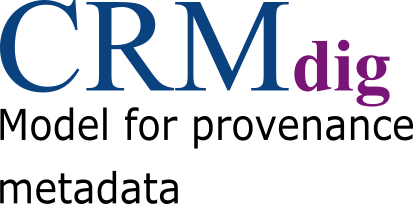Posted by George on 25/8/2021
I am working on a conservation science modelling project in which the users document also their machinery. Something that comes up is that they want to document the kind of property or variable that is measured by the machine. This is a property of the machine, what it can do (dunamis).
We of course already have p103 was intended for
http://www.cidoc-crm.org/Property/P103-was-intended-for/version-7.1.1
I already make use of this for the purpose of documenting the general kind of method the machine can be used for.
But when you run the machine, it tests for certain variables and produces a resulting output which is a digital record of a signal carrying that variable.
This reminds me of some elements from CRMSci and from CRMdig
CRMSci has observations that look for property types:
S4 Observation
O9 observed property type E55
http://www.cidoc-crm.org/crmsci/sites/default/files/CRMsci%20v.1.3.pdf
We also have in CRMdig both a class for instruments (digital ones)
D8 Digital Device
and we again have a notion of an observation kind of event measuing a kind of thing
D11 Digital Measurement Event
L17 measured thing of type E55
http://www.cidoc-crm.org/crmdig/sites/default/files/CRMdig_v3.2.1.pdf
So, anyhow, putting that all together, I note:
people document their scientific machines and what they do
some of the properties pertain to the machine (it may measure only these things)
there are several references to such a property already in crmsci and dig but placed on the event.
So I wonder, for discussion, is there an interest in an instrument class (possibly beginning a bridge between sci and dig) which would not just be a leaf node but have its own substantial properties. I suggest a first one might be something like 'measures property/variable of type'.
This is not yet a proposal for such a thing, just an invitation to discussion for those who are interested on the potential utility of such an addition.
Posted by Martin on 1/9/2021
Hi George,
I think this is a good idea, of course, we should first look at a more specific property, since "instruments" can be very heterogeneous, or we concentrate on measurement devices in a narrower sense.
Posted by Thanasis on 6/9/2021
I think this would be a useful discussion and class. It has also been proposed within the PARCOURS model although perhaps a tighter proposal can be made.
Thanasis
P.S. The example for P103 could do with updating...
Posted by Martin on 7/9/2021
Dear All,
Just to give you a picture of the diversity and complexity we discuss.
Probably the high-end in complexity is a DNA - taxonomic distance measurement, a procedure, even though straightforward and deterministic, as I understand, with an great number of steps, a series of instruments subsequently used and possible errors in each one.
Interesting also a LIPS / Raman analysis of painting colorants, which uses multiple instruments until the final result, not reliably quantitative and including assumptions about a limited set of possible colorants that might be wrong.
As the most simple ones we may have yard sticks, but the most exotic in simplicity I can think of are pyrometric cones. They are used worldwide to monitor ceramic firings in industrial kilns, pottery kilns, for a one-time measurement of the maximum temperature reached by firing a kiln. They are calibrated to one temperature only, but normally destroyed by the measurement.
What is "one instrument", and are pyrometric cones and yardsticks instruments? What about body parts (ells, feet)
Posted by Robert Sanderson on 7/9/2021
I'm happy to take a homework to write up DNA measurement with CRM and Instruments in mind :)
[My wife used to work for Illumina, and then for one of their biggest customers, and was part of the team that discovered the markers that led to Grail]
Posted by Martin on 7/9/2021
Great! Critical question: What constitutes a single instrument, and where do we draw a line to tools? I'd argue that one measurement instrument should be able to yield a quantitative result, and be a sort of "black box" integrated device, such as the sequencing machines.
Question: yardsticks are "passive". Are they still instruments, even though the human eye is the instrument? I think they are a different category of calibrated objects for comparing, such as color charts etc.
Posted by Oyvind Eide on 7/9/2021
Really interesting distinction. When doing pre-digital surveys for maps we used the compass for direction (clearly an instrument, and active?) and bodily calibrated steps to count the meters of distances (clearly part of the human body). Still the results of these measurements were more or less equally (in)accurate and were recorded in a similar way (pencil on transparent paper).
Can we define by function? Are instruments just anything used for measurements? Neat solution but will lead to quite counter-intuitive claims I fear.
I am sure the homework will lead to some further questions, hopefully bringing us further.
In the 60th joint meeting of the CIDOC CRM and ISO/TC46/SC4/WG9 & 53rd FRBR/LRMoo SIG, the group resolved to close the issue on the grounds that it has been inactive since 2021, and aside the first intention to work on the issue, there was never any HW submitted.
Issue closed
Bern, April 2025


